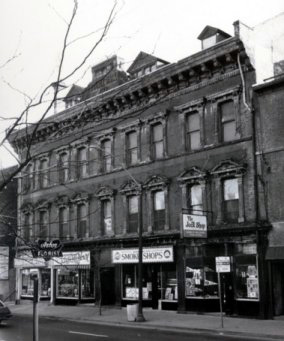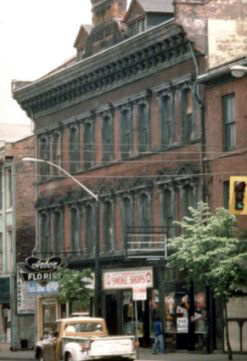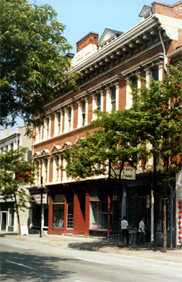
THE HEART OF THE CITY
TREBLE HALL
6-10 John Street North
CURRENT STATUS (1999) Barber shop; shoe repair
BUILDING INFORMATION
Date Built: 1879
Original Owner: Henry J. Larkin
Original Use: Retail, meeting hall
Subsequent Uses: SameARCHITECTURE
Size: Four floors
Architect, Builder: James Balfour, architect
Design and Style: Renaissance Revival
Construction Materials: Brick
Main Architectural Feature: Ornate sculptures of pressed metal that decorate the window openings; pilasters, entablatures, brackets, cornices and pedestals
Treble Hall, one of the finest surviving examples of Renaissance Revival architecture in Hamilton, was erected in 1879. The building was designed by Hamilton architect, James Balfour, who was noted for other famous designs including the Detroit Museum of Art and the Hamilton City Hall of 1888.
Historical documentation from 1879 reveals that the family of Henry J. Larkin originally owned the site upon which Treble Hall was built. The family was responsible for the erection of the building, however no one is certain as to why the pedestal on the roof reads "Treble Hall, 1879" since the Treble family purchased the building much later. Even before construction began, tenders in the newspaper referred to the building as "Larkin Hall". It is unknown as to whether the name "Larkin Hall" was ever formally inscribed on the building. The only certainty is that the Treble family purchased the land and building in 1893.
As early as April 14, 1879, the following advertisement appeared in the Spectator: "Stores and offices to let in the Larkin Block, corner of King and John Streets. These first-class premises are now ready for occupation, with plate-glass fronts, water, gas and all modern improvements. Rents reasonable." In July of 1879, the Sacred Philharmonic Society of Hamilton was hired by Henry Larkin to give a free concert in the assembly hall of the then recently completed three-storey building.
According to descriptions the building shows the characteristic of the Renaissance
Revival in the subordinate role of the flat brick walls, which
serve only as a backdrop for the rich and rather ornate sculptures of pressed metal that
decorate the window openings. The decorations tended to be classical in derivation and
formal in presentation. This is shown through the pilasters, entablatures, brackets,
cornices and pedestals. The one thing that is missing from the original fašade is the
fanciful ball finials that topped each window. The first floor always housed shops, while
the second floor was originally used for offices. The third floor contained an assembly
hall which seated 400, while an almost invisible fourth floor was only detectable by the
tiny windows set into dormers. The storefronts of Treble Hall have changed little from
their original design and the original pressed metal of panelled Corinthian pilasters
survives.
subordinate role of the flat brick walls, which
serve only as a backdrop for the rich and rather ornate sculptures of pressed metal that
decorate the window openings. The decorations tended to be classical in derivation and
formal in presentation. This is shown through the pilasters, entablatures, brackets,
cornices and pedestals. The one thing that is missing from the original fašade is the
fanciful ball finials that topped each window. The first floor always housed shops, while
the second floor was originally used for offices. The third floor contained an assembly
hall which seated 400, while an almost invisible fourth floor was only detectable by the
tiny windows set into dormers. The storefronts of Treble Hall have changed little from
their original design and the original pressed metal of panelled Corinthian pilasters
survives.
From 1879 to 1893, the building was owned by the Larkin Family and was subsequently taken over by Samuel Treble. The building remained in the possession of the Treble family until the 1940s. When Samuel Treble died in 1899, his brother, John Treble, became owner of Treble Hall. In 1930, Arthur H. Treble took over ownership of the building and then passed it on to his executors.
The Treble family, in addition to owning Treble Hall, also possessed a men’s furnishing and clothing store called Treble’s, which was founded in 1865 by J.M. Treble. The main store was located in the central commercial district of King and James Streets while a branch store was opened at King and John Streets. The store imported immense shipments of men’s furnishings, hats, and coats from England, Italy, Germany, Austria and the United States. In late December of 1922, Treble’s was taken over by Sanders and Connell Limited. Harry Sanders and Harry Connell were both experienced haberdashers who had been associated with the Treble’s organization for more than twenty years.
 Over the years, Treble Hall was occupied by an
interesting mixture of professionals, labourers, and merchants, including barbers,
printers, dyers, and architects. Some of the tenants that stayed the longest were James A.
Cox, printer, who was a tenant for 40 years, and Robert Parker, dyer, who remained in the
building for 18 years.
Over the years, Treble Hall was occupied by an
interesting mixture of professionals, labourers, and merchants, including barbers,
printers, dyers, and architects. Some of the tenants that stayed the longest were James A.
Cox, printer, who was a tenant for 40 years, and Robert Parker, dyer, who remained in the
building for 18 years.
The upper floors were at one time turned into apartments but have remained vacant since the early 1960s. In 1979, the top floor of Treble Hall was closed and the middle floor served as a kitchen for the restaurant located at 85 King Street East.
In 1986, the building was given a facelift. Work crews were busy peeling over a century of grime off the neglected fašade. The sandblasting of the brick and painting of the intricate pressed metal sculptures around the windows cost approximately $30,000.
Today, Treble Hall is owned by the Wertmans of Willowdale and is occupied by a barber shop and shoe repair store.
REFERENCES: